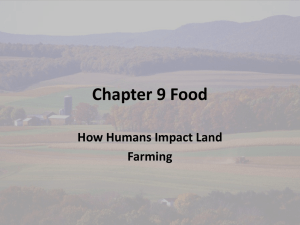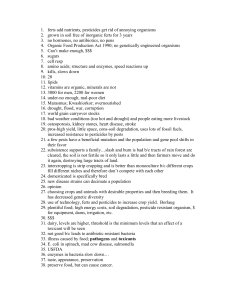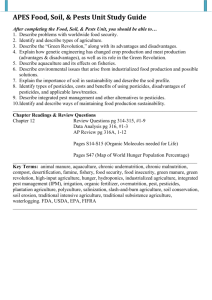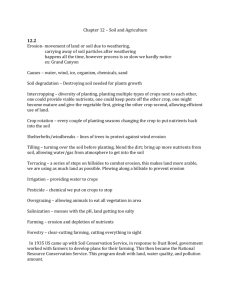G_1956_Food_Sustainability_Module
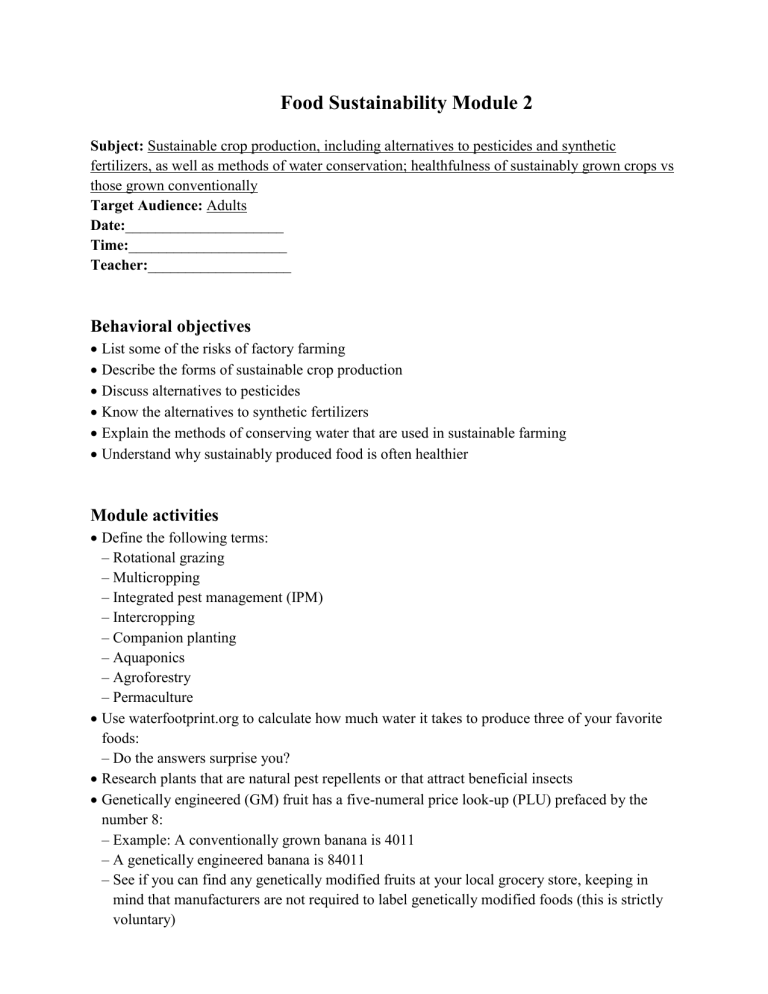
Food Sustainability Module 2
Subject: Sustainable crop production, including alternatives to pesticides and synthetic fertilizers, as well as methods of water conservation; healthfulness of sustainably grown crops vs those grown conventionally
Target Audience: Adults
Date: _____________________
Time: _____________________
Teacher: ___________________
Behavioral objectives
List some of the risks of factory farming
Describe the forms of sustainable crop production
Discuss alternatives to pesticides
Know the alternatives to synthetic fertilizers
Explain the methods of conserving water that are used in sustainable farming
Understand why sustainably produced food is often healthier
Module activities
Define the following terms:
–
Rotational grazing
–
Multicropping
– Integrated pest management (IPM)
–
Intercropping
–
Companion planting
–
Aquaponics
–
Agroforestry
– Permaculture
Use waterfootprint.org to calculate how much water it takes to produce three of your favorite foods:
–
Do the answers surprise you?
Research plants that are natural pest repellents or that attract beneficial insects
Genetically engineered (GM) fruit has a five-numeral price look-up (PLU) prefaced by the number 8:
–
Example: A conventionally grown banana is 4011
–
A genetically engineered banana is 84011
–
See if you can find any genetically modified fruits at your local grocery store, keeping in mind that manufacturers are not required to label genetically modified foods (this is strictly voluntary)
Lesson sequence
1.
What is the impact of farming on the environment?
Farming practices have a huge impact on the environment, animal welfare, and the nutritional content of the animal products that we consume.
Pasture-raised animals are allowed to roam freely and to eat nutritious grasses when they are hungry. In contrast, many animals today live their entire lives in factory farms. They are confined to a very small area, are not able to control what they eat or how much they eat, and get little to no physical activity. These animals often get no fresh air or sunlight.
Rotational grazing is a management-intensive grazing system that takes animals out of barns to pastures to provide high-quality forage and reduced feed costs, while avoiding manure buildup.
What are some of the risks that occur as a result of factory farming?
Keeping animals in such close quarters creates a breeding ground for bacteria:
–
These animals then need more antibiotics to fight or prevent infections
–
These antibiotics are then transmitted to us when we eat meat or drink milk
–
This may lead to resistant bacteria that today’s antibiotics cannot handle
Animals on factory farms often eat chicken manure, plate waste from restaurants, and blood from other animals.
Many cows and other ruminants are forced to eat grains, which are not good for the animals.
Corn and soybeans are cheap and allow the animals to gain weight fast, which increases the farmer’s profit, but it has severe repercussions for the animals:
They often suffer intestinal damage, dehydration, and liver abscesses as a result
Some of these animals will die from the illnesses caused by eating grains that they are unable to digest
The food produced on factory farms is not as nutritious as the meat, eggs, and dairy from pasture-raised animals:
Pasture-raised animals lead to food that is lower in calories and fat, that is higher in vitamins, and that contains healthier fats
Factory farms often affect the environment:
The artificial fertilizers pollute our water and air
It takes a large amount of energy to produce the massive amounts of grain fed to the animals:
– A cow must eat 8 pounds of grain to yield 1 pound of meat
A massive amount of fossil fuel is used to truck feed and animal waste
2.
Can you think of any ways that crops are grown that are not ecologically or ethically responsible?
Sustainable food consists of growing food in an ecologically and ethically responsible manner.
Here are some examples of how crops are not grown responsibly:
Processes that harm the environment
Workers who are not treated well
Commercial fertilizers and pesticides that are extensively used
It is possible to grow crops more sustainably in many different ways, such as multicropping, where multiple types of plants are planted on one piece of land, either at the same time or in a rotation.
Growing plants such as rye or clover in the off season after harvesting a grain or vegetable crop provides many benefits, including weed control, erosion control, and improved soil nutrients and soil quality.
Growing a greater variety of crops on a farm reduces risks from extremes in weather, market conditions, or crop pests, and also contributes to soil conservation, wildlife habitat, and increased populations of beneficial insects. This also helps to prevent insects and pest infestation, and reduces weeds naturally so that chemicals are not needed.
In addition, growing a greater variety of crops increases production of crops over time by reducing pests, improving soil health, and increasing water retention:
Pesticides are dangerous to farm workers and to the people who eat the food that is covered in pesticide residue
Some pesticides are linked to cancer, neurological conditions, and other health problems
Pesticides also damage the environment via water pollution and soil contamination:
–
Pesticides can have unintended consequences, such as creating pesticide resistance
–
Pesticides decrease pollinators and other beneficial insects that are necessary for a healthy agricultural system
Many different ways are available to prevent pest infestation without the use of chemicals. IPM manages pests by combining biological, cultural, physical, and chemical tools in a way that minimizes economic, health, and environmental risks:
Monitoring and identifying pests before they become a threat
Intercropping—planting crops in close proximity to reduce weeds, encourage plant diversity, and avoid insect and pest infestation (also improves soil health)
Companion planting—using plants that are natural pest repellents, that are more attractive to pests than the primary crop, or that attract beneficial insects
Weeding or trapping to manually remove pests
Manually removing weeds and insects, although this is time-consuming
Using beneficial insects and organisms to destroy harmful pests (eg, ladybugs are a beneficial insect)
3.
What about water pollution?
Commercial fertilizers are a primary source of water pollution, may cause soil acidification, and contaminate soil with heavy metals. The production of inorganic fertilizer necessitates a great deal of fossil fuel use.
Central management of nitrogen and other plant nutrients improves the soil and protects the environment. Increased use of on-farm nutrient sources, such as manure and leguminous cover crops, reduces the need to buy fertilizer.
Alternatives to synthetic fertilizers keep the soil healthier, increase soil biodiversity, and increase the uptake of nutrients by plants:
Compost
Animal manure
Seaweed
Worm castings
4.
What about soil erosion?
The plowing of industrial farming leads to soil erosion and compaction, decreased aeration (bad for plant roots), and loss of water and nutrients. The machines also run on oil.
Mulching manually controls the growth of weeds and reduces soil erosion:
Groundcover helps to control weeds
Many soil conservation methods, including strip cropping, reduced tillage, and “no till,” help prevent loss of soil because of wind and water erosion
5.
What is involved in sustainable crop production?
Sustainable crop production includes methods of water conservation and sustainable irrigation.
Many practices improve quality of drinking and surface water, while also protecting wetlands.
Wetlands play a key role in filtering nutrients and pesticides, in addition to providing a wildlife habitat.
You can use the Web site www.waterfootprint.org
to calculate how much water was used to bring your food to the table. For example, on average:
One apple (150 gram [g]) costs 125 liters of water
One large banana (200 g) costs 160 liters of water
Farmers can reduce water usage by the following methods:
Low-volume irrigation
Rainwater catchment
Planting drought-resistant crops
6.
Are other forms of sustainable crop production used?
Many other forms of sustainable crop production are used, including:
Aquaponics—raising aquatic animals in a symbiotic environment with hydroponically grown plants
Agroforestry—covers a range of tree uses on farms, including interplanting trees with crops or pasture, better managing woodlots, and using trees and shrubs along streams as riparian buffer strips
Permaculture—an agricultural philosophy that combines agroforestry, intercropping, mulching, and rainwater catchment
Rooftop farms and other methods of urban agriculture—bringing food production closer to home
7.
Does sustainable farming benefit farmworkers?
Many farmworkers are subjected to toxic exposure to chemicals, very poor living conditions, and very low pay. Sustainable farm managers generally treat workers fairly and pay a fair wage.
Sustainable farming supports local communities.
8.
What are the other benefits of sustainably produced foods?
Are often healthier
Are harvested closer to their peak ripeness (fruits and vegetables)
Improve the health of the soil, allowing plants to absorb more nutrients
Are transported shorter distances and stored for less time, which retains more nutrients
Do not utilize genetically engineered crop varieties
Fruits and vegetables grown on industrial farms are bred for high yield, ease of transport, and fast growth. Today’s produce that is produced on industrial farms is lower in nutrients and contains more water.
Industrial farms are so large that tracking foodborne illness outbreaks is nearly impossible. The unsanitary conditions of industrial farms greatly increase the risk of foodborne illness.
References and recommended readings
Food and personal health. Grace Communications Foundation Web site. http://www.sustainabletable.org/271/food-personal-health . Accessed November 5, 2013.
Sustainable agriculture: what is sustainable agriculture? United Nations Education, Scientific and
Cultural Organization (UNESCO) Web site. http://www.unesco.org/education/tlsf/mods/theme_c/mod15.html?panel=1#top . Accessed
November 5, 2013.
Sustainable crop production. Grace Communications Foundation Web site. http://www.sustainabletable.org/249/sustainable-crop-production . Accessed November 5, 2013.
Sustainable livestock husbandry. Grace Communications Foundation Web site. http://www.sustainabletable.org/248/sustainable-livestock-husbandry . Accessed November 5,
2013.
Contributed by Elaine Koontz, RD, LD/N
Review Date 11/13
G-1956

